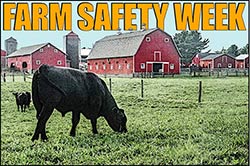Safety Awareness — Part 2:
Critical Errors
Rushing, frustration, fatigue and complacency can lead to critical errors of eyes not on task, mind not on task, placing one’s self in the line-of-fire, and losses of balance/traction/grip.
In the first article of this three-part series, we covered the “states” we find ourselves in that can often lead to injuries — rushing, frustration, fatigue and complacency. These states can lead us to make critical errors, wherever we are, Don Wilson of SafeStart told those attending the Michigan Safety Conference in Grand Rapids, Mich. Speaking on 24/7 safety awareness and the safety skills that business owners and employees can develop to reduce the likelihood of injury, he shared four critical errors that can result from these “states” — eyes not on task, mind not on task, line-of-fire, and balance/traction/grip.
Resulting errors
Eyes not on task often involves putting our body in motion without first looking where we are going. We could be in a vehicle, taking a walk, climbing a ladder — the many activities you do routinely. Taking that first step back without turning or looking, backing out of that parking spot without checking all directions, and taking a step up or down without looking in the direction you will be moving are all examples of eyes not on task.
Many injuries occur because we just don’t take the time to look first. It may be that we are in a hurry (rushing), frustrated over something we recently experienced, fatigued, or maybe we have just done the task so many times that we are not expecting a hazard to be present this time (complacency).
Mind not on task involves what many like to call “multi-tasking” today. The point is that there are times that we can safely multi-task and times that we should avoid it. When hazards are present, we should avoid multi-tasking and keep our mind on the task at hand.
All of the states can lead to mind not on task, but frustration and complacency top my list. We tend to carry our frustrations with us and dwell on them when we shouldn’t. If there’s enough hazardous energy present in what we are doing … Bam! … we can have a serious accident. Complacency convinces us that we have done the task “a million times” without any problems. If it's “old hat,” we can certainly solve that next problem while we are doing this task, or maybe send a quick text.
Line-of-fire suggests that sometimes we find ourselves in the path of a significant hazardous injury. Sometimes we even deliberately put ourselves in these situations. Wilson shared the example of not letting that vehicle in the next lane who keeps cutting in and out of traffic (“the weasel”) get between you and the vehicle in front of you.
Drivers will often ride bumper to bumper just to keep the weasel out, even though they have now put themselves in a line-of-fire situation. This would be an example of an error created by the state of frustration, but the other states can certainly also cause us to put ourselves in the line-of-fire without really thinking it through. At work, an example would be starting the tractor while standing on the ground — we are in the line-of-fire — a dangerous place to be.
The final critical error that can lead to injury is balance/traction/grip. Paying attention to your surroundings and the limitations of your machinery, equipment and even your own body are all important in avoiding this critical error. When we are rushing, frustrated, fatigued or complacent, we may not be paying close attention to the physical conditions around us.
In farming our highest rate of work-related fatalities is tractor rollovers, and those rollovers occur on relatively flat ground. We miss a ditch or a bump and we lose our balance and the tractor can turn over very easily. If we don’t have rollover protection on the tractor, and are not wearing our seatbelt, the results can be fatal.
The third and final article in this series by Michigan State University Extension and MIFACE will discuss “Critical Error Reduction Techniques” Wilson shared with the audience at the Michigan Safety Conference.
Other articles in this series:
• Part 1: States Leading to Injury
• Part 3: Critical Error Reduction Techniques
Editor’s Note: This article was published by Michigan State University Extension.






 by Stan Moore, Michigan State University Extension & Deb Chester, Michigan Fatality Assessment and Control Evaluation
by Stan Moore, Michigan State University Extension & Deb Chester, Michigan Fatality Assessment and Control Evaluation